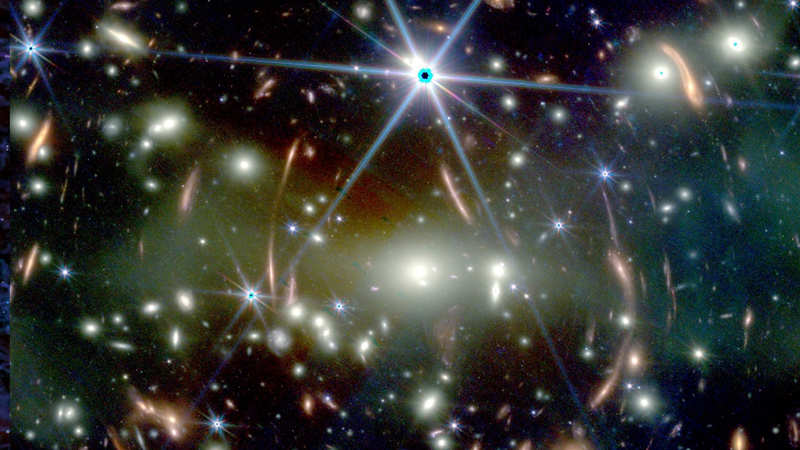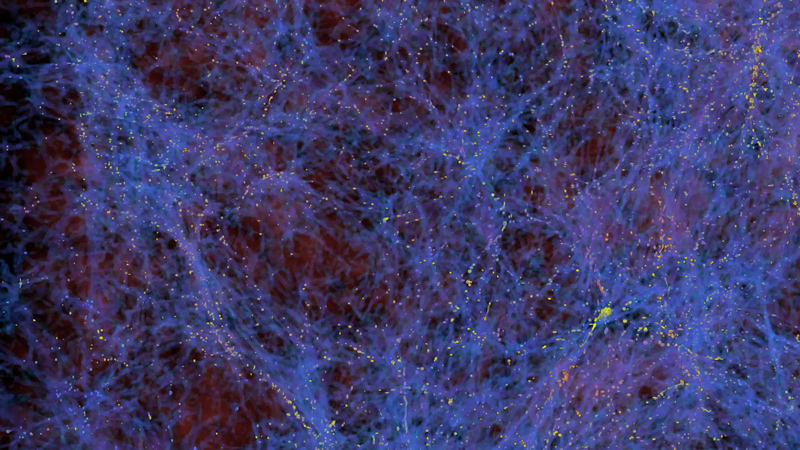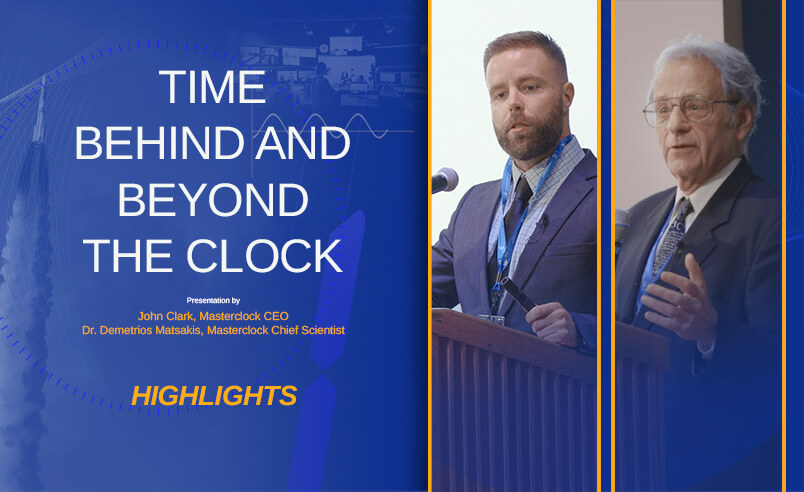06/23 By Dr. Matsakis
Shedding Light on Dark Matter
Recently an article appeared in Nature Astronomy suggesting that dark matter could be detected by flying a clock near the Sun[1]. If it succeeds there will be something poetic about it, because the very discovery of dark matter came from observing the suns that make up our universe.
 Figure 1. Dark Matter in the galactic cluster SMACS-J0723, as revealed by the James Webb Space Telescope. Credit: NASA, ESA, CSA, STScI
Figure 1. Dark Matter in the galactic cluster SMACS-J0723, as revealed by the James Webb Space Telescope. Credit: NASA, ESA, CSA, STScI
But what exactly do we mean by dark matter? Believe it or not, the Moon is dark. It reflects only 7% of the sunlight that falls on it. But the kind of dark matter this article is about would reflect 0% of the sunlight. It isn’t even made up of electrons or protons or quarks or anything that interacts with light. And it’s streaming through all of us right now.
What do we know about it? Dark matter constitutes about 27% of the mass-energy of the universe, while dark energy makes up about 68%, give or take[2]. We don’t know what dark energy is either, but that’s a different problem. According to the Big Bang theory, ordinary non-dark matter can only make up 5% of the total mass-energy because otherwise the amount of helium would differ too much from what we see. Actually, we only see about half that 5%, but we can worry about that later.
We’ve suspected some kind of dark matter may exist for a long time. Poincare first coined the term in discussing speculations Lord Kelvin made in 1884, because according to Newton’s laws there was too much gravitational pull given the number of stars. Newton showed that planets only move in stable orbits if their motion isn’t fast enough to escape the Sun’s gravity while not so slow as to be sucked into it. And because gravity gets weaker the further away you get, the outer planets have to move slower – they would escape if they had the same speed as the Earth.
The same kind of balance exists for “systems” of stars (or star clusters, galaxies, clusters of galaxies, even gas clouds - you name it). The mutual gravitational attraction between the components pulls them to the center of mass. But gravity is a force, so they speed up as they get sucked in. They could just pass through, go to the other side of the system, and then fall back so that nothing really changes. But too much gravity will bring about an overall collapse, and either their random motions will increase to attain a balance in a smaller volume or the whole thing will coalesce into a more condensed object, such as a black hole. Conversely, if the net gravitation is too weak the stars will move further out, where either gravity will slow them into stable orbits or they will escape the system. So for any stable system the velocity spread and the gravity will be in balance. It’s called the virial theorem. And if you measure the velocity distribution, you know the total mass needed for gravity to hold the system together (Figure 2).
 Figure 2. Stable systems of stars balance their mutual attraction against their random motions.
Figure 2. Stable systems of stars balance their mutual attraction against their random motions.
The problem is that every time somebody does the math for any system of stars, the total mass needed to hold it together is much more than the mass of the visible stars. And the larger the system is, the more the missing mass. In 1939 Horace Babcock observed this in the rotation in the Andromeda galaxy, the large spiral that will pass through us in 5 billion years— although he thought it was because dust clouds obscured the starlight. In 1933 one of my heroes, Fred Zwicky, photographed the Coma galaxy cluster and found it had only 1% of the mass needed to hold it together.
Things really went wild in the 1970’s, when Vera Rubin and others started photographing galaxies big time. They found that instead of the orbital speed decreasing as you got further out in galaxies, like it does with the planets of our solar system, the speeds of the stars and gas leveled off to a constant of about 200 km/s (about half a million miles per hour). That meant there had to be a lot more mass out there than was observed by starlight. The ratio of dark to ordinary matter goes up as get further out. In the solar neighborhood, the ratio is about 50-50.
Since then we’ve have found evidence of dark matter just about everywhere and in many ways – superclusters, gravitational lensing, and the anisotropies in the cosmic microwave background, which is the faint microwave glow left over from the Big Bang. Cosmologists have even discovered they need dark matter to correctly predict the parameters of the soap-bubble-like universe on the grand scale (Figure 3).
 Figure 3. Simulation of the universe, showing density filaments in blue and galaxy formation in yellow. Attribution: Dr. Zarija Lukic, as appeared on NASA.gov
Figure 3. Simulation of the universe, showing density filaments in blue and galaxy formation in yellow. Attribution: Dr. Zarija Lukic, as appeared on NASA.gov
There are many theories as to what dark matter is. Solar-mass black holes, neutrinos, hypothetical elementary particles, and new physics have been proposed. There are even Modified Newtonian Dynamics (MOND) theories, in which the gravitational force doesn’t get as weak at long distances as Einstein and Newton thought. Perhaps the most far-out possibility was discussed at the May 2023 International Frequency Control Symposium meeting. This is that dark matter may be composed of unrecognized elementary particles, each having the size of a dwarf galaxy but weighing only 10-23 of an electron’s mass. All these theories have their advocates, but none have a large following among astronomers.
So why haven’t we found it? Maybe because we don’t have good enough clocks. The basic frequencies of the oscillators inside the clocks depend on fundamental constants of physics. If dark matter swished by them, the so-called weak force would perturb the energy levels of the atoms, and we might see a momentary change of their internal workings and their frequency too. Many people have looked for such things. Me too, when I was director of the USNO’s Time Service Department. Following a suggestion by Prof. Lord at the University of Washington, I rotated some cesium beam clocks so that if a stream of dark matter particles was coming from any particular direction it would selectively perturb the strength of the atomic forces and cause the phase lock loops in those clocks to work differently. Others have looked for correlated variations in the frequencies of the clocks on GPS satellites on opposite sides of the Earth[3]. Also by comparing clocks using different atomic species, which would have different sensitivities to a dark matter stream. If anybody had found anything interesting, we’d all know about it already.
Now back to the paper that inspired this article [4]. What if dark matter is gravitationally trapped by the Sun? Its greater density there would make it easier to detect. So you might fly two or more clocks based on different atomic species as close as practical to the Sun, and see what happens to the ratio of their frequencies. It would be a test of many things. A null result would confirm general relativity far more accurately than similar tests on and near Earth, and it would serve to constrain the amount of dark matter of certain types. A differential variation of the two clocks would open a new window for exploring dark matter and the limits of relativity. It’s a win-win.
There are of course more than a few engineering challenges, including but far from limited to advancing clock technology. But history shows it can be done. Clocks based on optical atomic transitions are routinely attaining precisions of 18 decimal points; they can be space-hardened, with more reliable components. The Parker Space Probe made it ten times closer to the Sun than Mercury’s orbit. We can do the same.
I once heard Jocelyn Bell, discoverer of pulsars, say that learning the nature of dark matter was on her bucket list. I mentioned this in a SciFi short story that suggests we enter the dark matter world after we die [5]. But I don’t want to wait that long, so I hope NASA funds the proposed mission!
Footnotes
[1] Yu-Dai Tsai, Joshua Eby, and Marianna S. Safronova, “Direct detection of ultralight dark matter bound to the Sun with space quantum sensors”, Nature Astronomy, 5 December 2022. The Institute of Navigation asked me to write an article on this for their newsletter and this blog is an updated version. The ION newsletter has some good articles too, and can be found here.
[2] Dark energy is the reason the universe is expanding faster and faster over time, rather than expanding less fast or even slower over time. It can be put into Einstein’s field equations so that its effects get stronger over distance. I was skeptical when people first claimed that the observations of supernovae (exploding stars) at large distances indicated the early universe was expanding slower. That was at the turn of the last century. The frequency shifts in their spectral lines (color change, you can say) tell us how quickly they are moving away from us, while their brightness tells us how far away they are. How far away means how long it took light to reach us. Putting it all together tells us how fast things were moving at that time. I doubted because back in the 70’s some astronomers claimed to have seen an acceleration too - but it turned out they had misapplied a correction for the darkening effects of dust. My doubts went away when better data showed that in the earlier universe the expansion was slowing down; it started speeding up only after it reached a certain size. This makes sense because dark energy should need some distance before it can start to overwhelm gravity. The discovery won three astronomers the Nobel prize in 2011, and dark energy could also be inferred through the correlations between galaxy separations. But guess what? Some astronomers claim that dark energy is an illusion due to us being in a low-density matter bubble.
[3] For example, some highly respective workers at the Royal Observatory of Belgium found data from clocks in the Galileo satellite system consistent with a blob of dark matter the size of the Earth having recently passed by. As they noted in their talk at May 2023 joint meeting of the International Frequency Symposium and European Forum on Time and Frequency, consistency is far from proof. Hopefully in follow-up work they will look at GPS, Beidou, and Glonass clocks simultaneously.
[4] Just about every new astronomical mission has a goal of learning something about dark matter. But this one might actually touch the stuff.
[5] D. Matsakis, “Beyond”, Altered Reality, 2018
About Dr. Demetrios Matsakis
 Dr. Demetrios Matsakis attended MIT as an undergraduate and received his PhD in physics from UC Berkeley, where he studied under the inventor of the maser and laser; and built specialized ones in order to observe interstellar dust clouds where stars are born. His first job was at the U.S. Naval Observatory, building water vapor radiometers and doing interferometry to observe quasars and galaxies at the edge of the observable universe. After developing an interest in clocks, Dr. Matsakis would spend the next 25 years working hands on with most aspects of timekeeping – from clock construction, to running the USNO’s Time Service Department, to international policy. He has published over 150 papers and counting, but gets equal enjoyment out of beta-testing his personal ensemble of Masterclock products.
Dr. Demetrios Matsakis attended MIT as an undergraduate and received his PhD in physics from UC Berkeley, where he studied under the inventor of the maser and laser; and built specialized ones in order to observe interstellar dust clouds where stars are born. His first job was at the U.S. Naval Observatory, building water vapor radiometers and doing interferometry to observe quasars and galaxies at the edge of the observable universe. After developing an interest in clocks, Dr. Matsakis would spend the next 25 years working hands on with most aspects of timekeeping – from clock construction, to running the USNO’s Time Service Department, to international policy. He has published over 150 papers and counting, but gets equal enjoyment out of beta-testing his personal ensemble of Masterclock products.

